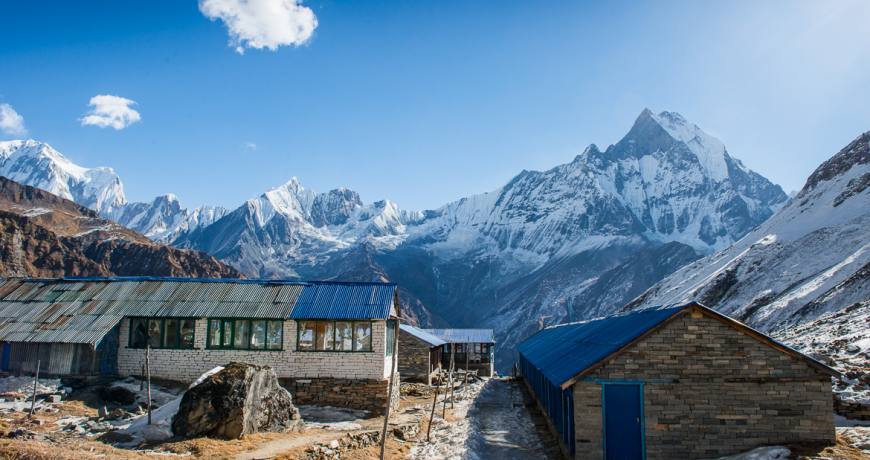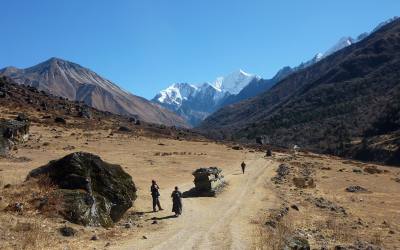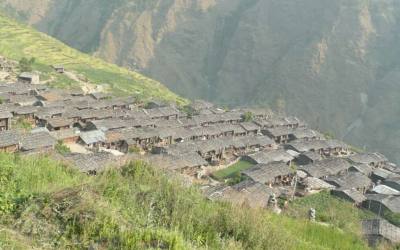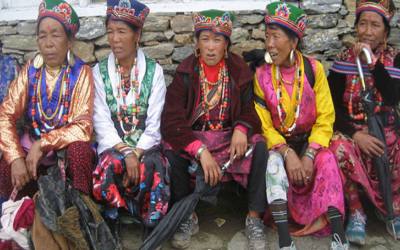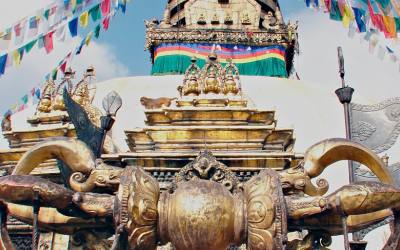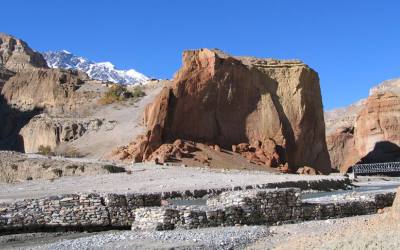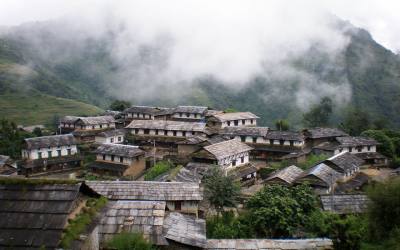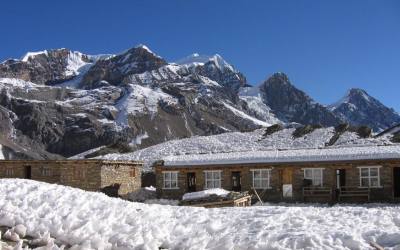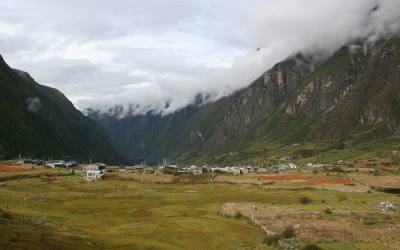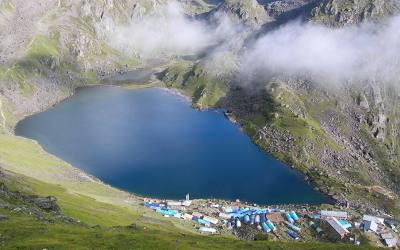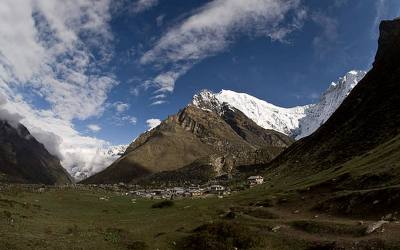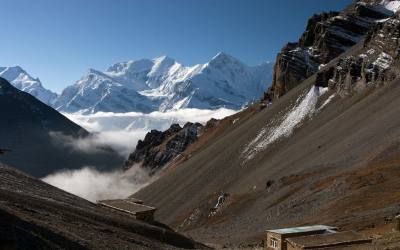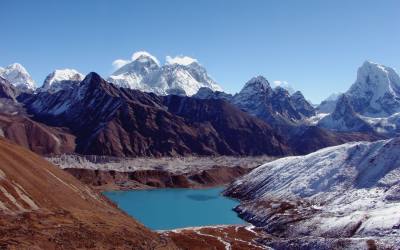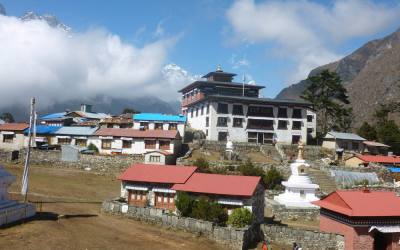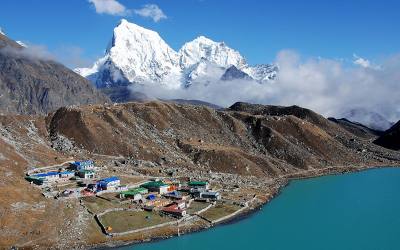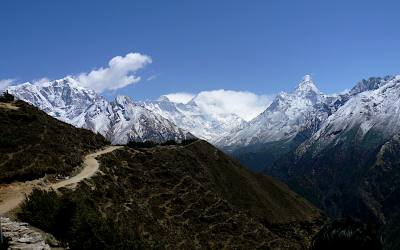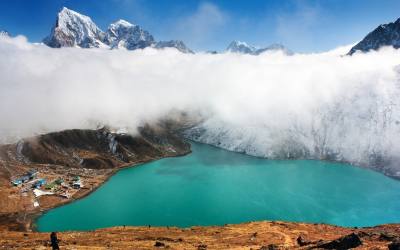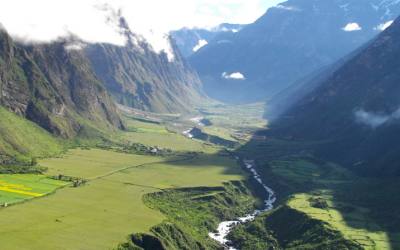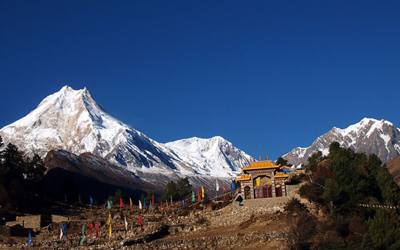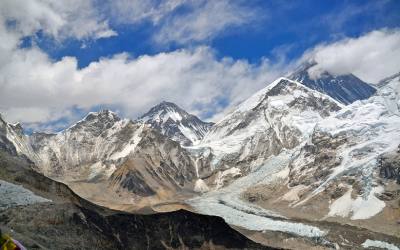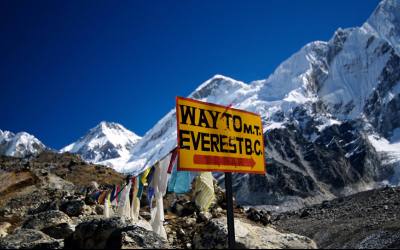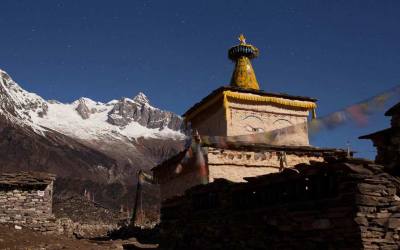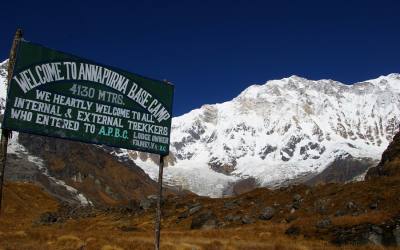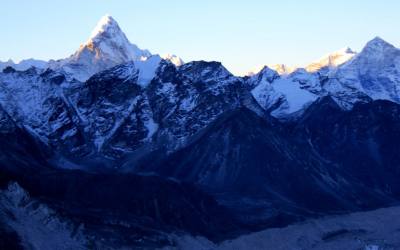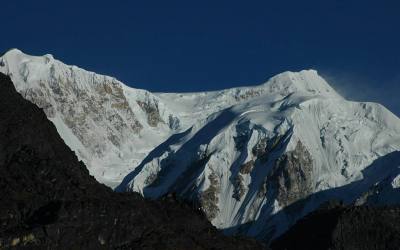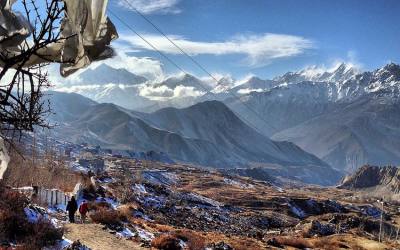Annapurna area is the most popular trekking region in Nepal, every year visited by 70 percent of trekkers, and for good reason. the deep valleys and high mountains encircling the giant Annapurna himal embrace a wide range of peoples and terrains, from subtropical jungle to a geographic extension of high, dry , Tibetan Plateau. The scenery is superb mix of lush vegetation, mountain peaks and an endlessly changing procession of people.
Flora and Fauna
The range of geographical and climatic regions has led to a diverse variety of flora and fauna with in the Annapurna region. these parts of area are heavily cultivated and the landscape is terraced paddy fields for most of the year.the higher up in the hills the natural vegetation changes from the tropical species to more temperate stands of forest trees including oak, beech and rhododendron.
Trekking styles:
Most of the trekking routes in the Annapurna region are well serviced by teahouses for most of their length. This is particularly true for most popular treks-the Jomsom trek, the Annapurna circuit and Annapurna base camp treks.
Trekkers should be aware, however that there is always the risk of being stranded by bad weather or injury/sickness between teahouses, particularly in the more remote parts of the trek itineraries. a good example is on the Annapurna circuit where there is one very long day when the high pass of Thorong La has to be crossed. There is little or no shelter available for most of this day and some trekkers have been caught unprepared by bad weather and altitude problems.
The treks in less developed areas, particularly the Dhaulagiri circuit and the trek east of Lamjung, definitely require trekkers to be self sufficient in food and shelter.
People and culture
The most prominent ethnic groups in the Annapurna region are the Gurung, the Thakali and the Manangba. The Gurungs are the most widely distributed being found from the hills of Gorkha district to as far west as Palpa. There heartland, however, is centered on the hills and valleys between the Marsyandi river and the kali Gandaki. The Thakali come from the upper kali Gandaki valley around Jomsom where their traditional farming has being supplemented by trade and, in particular, hotel and restaurant businesses. The Manangba are found in the upper reaches of the Marsyandi River and are in many ways similar to the Gurungs to whom they are possibly related. They are skilled traders and trace their roots back to Tibet. Religiously, the Manangba and the Gurungs of the upper hills is Buddhist with traces of their ancient, shamanistic faith still apparent. The communities live further south are predominantly Hindu.
All of the communities, particularly the Gurungs are famed for their cultural performances, which are easily seen while trekking in the region. Many villages along the trails will arrange performances for trekkers during the main seasons.
When to visit?
As with most of the trekking areas in Nepal, the best time to visit are during spring and autumn. Spring is the time for rhododendrons while the clearest skies are found after the monsoon in October and November. At these times the weather is generally mild and there is little rainfall. Unlike other parts of Nepal, the monsoon, from June to September, is the ideal time to visit pats of the region that falls in the rain shadow. In particular, upper mustang is the perfect destination during the rainy season. The winter months provide good trekking conditions throughout the foothills but some of the higher passes will be closed due to snow.
The other classic trek in the Annapurna region is to the so called Annapurna sanctuary, the site of the base camp used by expeditions attempting the massive south face of Annapurna I. a short trek, it can be completed in as little as eight days from Pokhara. The trek to Annapurna base camp combines some of the most spectacular mountain scenery with a fascinating insight into the life of middle hill Nepalis. The best time to visit the sanctuary is during the main trekking season of spring and autumn but since the route is not a circuit, the trial, and the teahouses, can become crowded at these times. Winter trek are possible but at any time trekkers must beware of snowfall and avalanches that can block the narrow entrance to the sanctuary.
This trek is usually started and ended in Pokhara but it can also be made a part of the Annapurna circuit or the Jomsom trek by trekking from Tatopani through Ghorepani and Tadapani and joining the main sanctuary trial at Chomrong. For maximum enjoyment, allow twelve or fourteen days for the trek, which allows time for exploration inside the sanctuary and also the chance to extend the route on to Ghorepani and Poon hill. Trekkers traveling this route must obtain an ACAP entry permit either from Kathmandu or Pokhara before commencing the trek.
Day01: Arrival and Transfer to hotel in kathmandu.
Day02: Free day in kathmandu or self sight seeing around valley
Day03: Kathmandu to Pokhara by regular tourist bus. The drive will take 7 hrs.
Day04 :Pokhara to Nyapul by private transport than by trek to Ghandruk village(1940m) 5-6 hrs of trek
Day05: Ghandruk village to Tadapani (2650m) 5-6 hrs of trek
Day06: Tadapani to Bayli Kharka (3450m) 5-6 hrs of trek
Day07: Bayli kharka to upper Chistibung (2950m) 4 hrs of trek
Day08: Chistibung to Kopra Ridge (3600m)3- 4 hrs of trek
Day09: Kopra Ridge to Swanta (2220m) 5-6 hrs of trek
Day10: Swanta to Ghorepani (2850m) 4 hrs of trek
Day11: Ghorepani – Poon hill to Hille (1700m) to Birethanty then by private transport to Pokhara (827m) 7-8 hrs of trek
Day12 : Free day in Pokhara or self sight seeing around valley
Day13: Return back to kathmandu by regular tourist bus. 7 hrs of driving
Day14: Free day in kathmandu or self visiting around the kathmandu valley
Day15: Tour Ends ( Departure for onwards destination)
Day 01: Arrival and transfer to hotel in Kathmandu
Upon arrival in Kathmandu. Our airport representative will be waiting outside the airport terminal a few metres from the exit door. Please check your name at play card. He will bring you to hotel in kathmandu. The drive from the airport to the hotel is around 20 minutes.
Day 02:Free day in Kathmandu or self sight seeing around valley (option are)
Mount Everest flight
It is possible to book a flight to see Mount Everest whilst you are in Kathmandu. The cost is US$205.00 (subject to change) per person .
The one hour Everest flight takes off from Kathmandu Airport and flies east where you can see magnificent mountains, including Mount Everest, from a height of around 25,000 feet. You can enjoy a seemingly endless chain of snow capped peaks as you fly above the clouds, over glaciers and lakes, rivers and gorges from your private individual window. This excursion offers a great opportunity to experience and photograph the aerial view of the highest mountain peaks in the world, the Kathmandu valley and the landscapes of Nepal.
Swoyambunath Temple(Monkey Temple)
The famous Swayambunath Temple is perched on a hill outside Kathmandu and has a square golden stupa rising from a lovely white dome. Monkeys play on the steps up to this temple. Swayambhunath is said to be more than 2000 years old and is a very holy place for Buddhists as well as Hindus. You have a wonderful view over Kathmandu from here.
Boudhanath stupa
Boudhanath Stupa (or Bodnath Stupa) is the largest stupa in Nepal and the holiest Tibetan Buddhist temple outside Tibet . It is the center of Tibetan culture in Kathmandu and rich in Buddhist symbolism. The stupa is located in the town of Boudha , on the eastern outskirts of Kathmandu .
History
Bodnath was probably built in the 14th century after the Mughal invasions; various interesting legends are told regarding the reasons for its construction. After the arrival of thousands of Tibetans following the 1959 Chinese invasion, the temple has become one of the most important centers of Tibetan Buddhism. Today it remains an important place of pilgrimage and meditation for Tibetan Buddhists and local Nepalis, as well as a popular tourist site.
Pashupatinath Temple (Famous Hindu Temple)
Situated 5km east of kathamandu, the temple of Lord Shiva , Pashupatinath, with two tired golden roof and silver door is considered one of the holiest for Hindus. Although only Hindus are allowed inside the temple, visitors can clearly see the temple and the activites performed in the Temple premises from the eastern bank of the Bagmati river. The Temple was listed in the UNESCO world heritage Monument List in 1979
Day 03:Kathmandu to Pokhara by tourist bus. The drive will take 6-7 hours
Early in the morning take a tourist bus to Pokhara. The bus journey will take 6 -7 hrs.over night at hotel in Pokhara.
Day 04:Pokhara to Birethanty by private transport than by walk to Ghandruk village (1940m)
We continue to traverse following the Modi Khola upstream passing through settlements inhabited by the Chettris and Brahmins. The trail continues to traverse and one can see the Machhapucharre (6993m) on a clear day looming majestically in the distance. We reach the small hamlet of Shyauli Bazaar . From Shyauli after a pleasant tea stop we start the climb to Ghandruk. The trail gradually climbs out of Syauli and we cross a steel suspension bridge after which the trail climbs up on stone steps. The trail steepens and continues to climb passing through settlements of Klieu, Kimche and Chane and one can see the beautiful scenery and the village life. From the small village of Chane the trail traverses and then climbs up to the big Gurung village of Ghandruk, where we stop for lunch and spend the night. Ghandruk is one of the biggest Gurung village in that area and one can see the difference in the lifestyle of the Gurungs to that of their neighbours in the lower areas. Ghandruk is well known for the number of its menfolk who have served in the British Gurkha regiments. From our lodge at Old Ghandruk, we have spectacular views of Annapurna South (7219m), Hiunchuli (6441m) and Machapuchhare (6993m) and Hiunchuli ( 6434m).
Day 05:Ghandruk village to Tadapani (2650m)
(Trekking: approx 4 hours) Another day ascending, but an easier walk now that we have found our trekking legs! Leaving the terraced hillsides and the village of Ghandruk behind we enter oak and rhododendron forest. This is a particularly pretty part of the walk, the forest often alive with the sound of birds, the small tumbling waterfalls and if you visit in spring, (late March to April) the rhododendron in full bloom. There are no villages on to days route, but there are a few teahouses at Baisi Kharkha providing welcome drinks and a place to rest. There are fine views of Annapurna II (7937m), Annapurna III (7555m), Annapurna IV (7525m), Annapurna South (7237m), Machhapuchhare (6993m) and Lamjung Himal (6931m) along the way.
Day 06:Tadapani to Bayli Kharka (3450m)
(Trekking: approx 6 hours) We leave the main trail that leads to Ghorepani and instead follow a rarely used trail initially through a thick rhododendron forest that leads to local water buffalo pastures. The climb is gradual and we soon emerge above the tree line to superb views of the Annapurna range. We take lunch by a small stream and, in the afternoon, continue to climb gradually though open countryside to reach a small pass, where our trail descends through rhododendron to an open clearing known as Bayli Kharka . From the lodge there are great views of Dhaulagiri range.
Day 07: to Upper Chistibung (2950m)
(Trekking: approx 5 hours) In the morning we descend through open ground and forest to reach the pastures of Lower Chistibung, where we take lunch. In the afternoon we continue to walk through forest, ascending gradually and passing through several buffalo grazing pastures to reach a clearing and temporary herders settlement, known at Upper Chistibung, where we stay in the small community lodge.
Day 08:To Kopra Ridge (3600m)
(Trekking: approx 3 hours) To reach the ridge at Kopra we have a steady climb that takes us above the tree line. This area is noted for wildlife and we should keep our eyes open for Himalayan tahr and Danfe pheasant. The best way to tackle the climb is to ascend steadily, take our time and rest as often as we wish. We reach our campsite on Kopra Ridge in time for lunch and we will be greeted more fantastic views. This extraordinary panorama includes Annapurna South, towering directly above and only six kilometres away, and Fang and Nilgiri prominent to the north, whilst across the depths of the Kali Gandakhi Valley, the Dhaulagiri Himal dominates the entire western skyline.
Day 09:To Swanta (2220m)
(Trekking: approx 5 hours) From Kopra Ridge we descend off the hillside and continue steeply downhill. We retrace our route back to Chistibung, then on to the village of Swanta, where we overnight at the community lodge.
Day 10:To Ghorepani (2850m)
(Trekking: approx 4 hours) From Swanta we descend through the village fields to a small river and take a quick look at the local water mill. From here we cross the suspension bridge and head upwards to the village of Chittre. Here we join the main trekking trail and it is a further ascent to reach the village of Ghorepani where there are great views of the Dhaulagiri Range.
Day 11:To Hille ( 1700m) to Nyapul than take a private car back to Pokhara
Early in the morning we will climb to poon hill ( 3210m) for sunrise tour and to see the views of Manasulu Range, Annapurna Range and Dhaulagiri Range.
After breakfast The walk passes through beautiful rhododendron forest . In the March or April the rhododendron should be in full bloom. We arrive at Ulleri , From here there are very steep descent of over 500 metres on a stone staircase to the Bhurungdi Khola River where we cross a small suspension bridge to reach the village of Tirkedunga. From here it takes around 20mins to arrive at Hille .
Follow the bank of river for two and haif hour and we will reach to Nyapul . from here take a private transport to Pokhara for one hour.
Pokhara is set in a lovely valley at the foot of the Machapuchare so you get spectacular views of the mountains from all parts of the town. It is quite different from Kathmandu, with few temples, but it does have plenty of scenic attractions and is close to the mountains. There are some interesting short walks or bicycle rides from Pokhara, you can swim and canoe on Lake Phewa or just watch the last rays of the sun stream across the dip in the mountains that hold the lake. Along the lakeside road there is a continuous stretch of small hotels, restaurants and shops; it’s an area which still has a bit of the old hippy scene feel about it.
Day 12: Free day in Pokhara and self sight seeing around Valley ( option are)
Pokhara is a remarkable place of natural beauty. Situated at an altitude of 827m from the sea level and 200km west of Kathmandu valley, the city is known as a center of adventure with several beautiful lakes and offers stunning panaromic views of Himalayan peaks.
The serenity of lakes and the magnificence of the Himalayas rising behind them create an ambience of peace and magic. So today the city has not only become the starting point for most popular trekking and rafting destinations but also a place to relax and enjoy the beauty of nature.
Pokhara is part of a once vibrant trade route extending between India and Tibet. To this day, mule trains can be seen camped on the outskirts of the town, bringing goods to trade from remote regions of the Himalaya. This is the land of Magars and Gurungs, hardworking farmers and valorous warriors who have earned worldwide fame as Gurkha soldiers. The Thakalis, another important ethnic group here, are known for their entrepreneurship.
The climate of Pokhara is slightly warmer than Kathmandu with daytime temperature hovering around 15 degrees Celsius in winter and 35 degrees in summer. The monsoon season which lasts from mid-June to mid-September is very wet; in fact Pokhara records the highest rainfall in the country. Best time to visit is between October and April.
The activities of foreign visitors to Pokhara focus around two districts known as Damside and Lakeside (or Pardi and Baidam, in Nepali, respectively). These two areas, with their strips of hotels and restaurants, are a few kilometers south-west of the main Pokhara bazaar. More
Sarangkot
The view of the Annapurna Himalaya from Sarangkot is almost a religious experience. From here, you can see a panoramic sweep of Himalayan peaks, from Dhaulagiri (8167m) in the west to the perfect pyramid that is Machhapuchhare (6997m) and the rounded peak of Annapurna II (7937m) in the east. Most people come here at dawn or dusk, when the sun picks out the peaks in brilliant colours.
Fewa lake
Fewa Lake, the second largest lake in the Kingdom, is the center of attraction in Pokhara. It is the largest and most enchanting of the three lakes that add to the resplendence of Pokhara.
Mahendra cave
Another of nature’s wonders in Pokhara is the Mahendra Gupha. This large limestone cave is locally known as the House of Bats, an apt name for it. A two-hour walk to the north of Pokhara, it is best to bring your own torch to see the stalactites and stalagmites, as well as the local winged residents.
Seti River
Another of Pokhara’s natural wonders that unfailingly interests visitors is the Seti river. Flowing right through the city, this river runs completely underground at places. Amazingly, at certain points the river appears hardly two meters wide. But its depth is over 20 meters! Mahendra Pul, a small bridge near the old Mission Hospital, provides a perfect view of the rivers’s dreadful rush and the deep gorge made by its powerful flow.
Barahi Temple
The Barahi temple is the most important monument in Pokhara. Built almost in the center of Phewa Lake, this two-storied pagoda is dedicated to the boar manifestation of Ajima, the protectress deity representing the female force Shakti. Devotees can be seen, especially on Saturdays, carrying male animals and fowl across the lake to be sacrificed to the deity.
Museum
The Pokhara Museum, located between the bus stop and Mahendra Pul, reflects the ethnic mosaic of western Nepal. The lifestyles and history of ethnic groups such as the Gurung, Thakali and the Tharu are attractively displayed through models, photographs and artifacts. One major attraction is a display highlighting the newly-discovered remains of an 8000-year-old settlement in Mustang.
Devi’s Fall
Locally known as the Patale Chhango (Hell’s Fall). Devi’s Fall (also known as Devin’s and David’s) is a lovely waterfall lying about two km south-west of the Pokhara airport on the Siddhartha Highway. Legend has it that a trekker (Devin, David..) was washed away by the Pardi Khola and disappeared down into an underground passage beneath the fall.
Day 13: Return back to Kathmandu by Tourist bus. The bus journey will take 6-7 hours.
Day 14: Free day in kathmandu or self visiting around the valley.
Bhaktapur
Situated at an altitude of 1,401m, Bhaktapur covers an area of four square miles. Bhaktapur or the city of Devotees still retains a medieval charm and visitors to this ancient town are treated to myriad wonders of cultural and artistic achievements. The past glory of the Malla rulers continues to be reflected at the Durbar Square. Pottery and weaving are its traditional industries. Bhaktapur is famous for woodcarving and the Bhadgaolen topi or cap. The city lies about 14 km east of Kathmandu and can be reached by public transport and by trolley buses.
Bhaktapur durbar Squares:
The Golden Gate is the entrance to the main courtyard of the Palace of 55 Windows.Built by King Ranjit Malla. The gate is one of the most beautiful and richly carved specimens of its kind in the entire world. This gate is embellished with deities and monsters with marvelous intricacy. The palace of 55 windows was built in 1700 AD. Among the brick walls in their gracious setting and sculptural design, is a balcony of 55 windows. This balcony is a masterpiece of wood carving. The stone temple of Batsala Devi which is also located in the Durbar Square is full of intricate carvings. This temple also sets a beautiful example of Shikhara style architecture in Nepal. There is a bronze bell on the terrace of the temple which is also known as the Bell of Barking Dogs.
This colossal bell, placed in 1737 AD, was rung to signal curfew those days.
The main square of the city contains innumerable temples and other architectural showpieces like the Lion Gate, the statue of King Bhupatindra Malla, the Picture Galley, the Batsal Temple, etc. A magnificent statue of King Bhupatindra Malla in the act of worship is placed on the column facing the palace. It was listed in the UNESCO World Heritage Monument list in 1979.
Changu Narayan:
Situated at the end of a long ridge which runs well into the Valley, It is said to have been built by king Hari Dutta in 323 AD said to be the oldest temple in the valley. It was listed in the UNESCO world Heritage Mountain list in 1979.
Patan
The ancient city of Patan, lying 5 km southwest of kathmandu, is known as the city of fine arts, The city is full of Hindu temples and Buddhist monuments. The diversity of the medieval culture that allowed both Hinduism and Buddhism to flourish has left a rich legacy of impressive sightseeing in this city for today’s visitors.
Patan Durbar Square:
Situated in the heart of the city, constitutes the focus of visitor’s attraction. The square is full of ancient palaces, Temple and shrines, noted for their exquisite carvings. The Patan durbar Square consist of three main chowks or countryards, the Central Mul Chowk, Sundari Chowk and Keshar narayan Chowk, The Sundari Chowk holds in its center a masterpiece of stone architecture. The Royal Bath called Tushahity. It was listed in the UNESCO world Heritage Monument list in 1979.
Krishna Mandir:
Built in 1637 AD, the temple of Lord Krishaa holds a commanding position in the palace complex of Patan. It is supposed to be the first specimen of Shikhara style architecture in Nepal. It is the only temple in Nepal having 21 spires and is completely 21 spires and is completely mad of stone.
Day 15: Tour Ends (Departure for onwards destination)
Price Per Person US$ 600.00 (Price are based on standard class hotel)
Price for meals and drinks during the trek Allow US$ 22-25 per person per day for trekking (off-course you are going to pay every day directly by yourself to the tea houses during the trek.it is just a guideline)
Single supplement US$ 150.00 per person ( you will get single room in kathmandu and during the trek. you can also book your trekking tour as a single with us. in this case we will charge little higher)
Additional night in kathmandu will cost US$ 35.00 for Double room with Bed and Breakfast and US$ 30.00 for single room.
Trekking prices with out hotel in kathmandu and in pokhara will cost US$ 500.00 per person.
Off-course it is always possible to upgrade the hotel in kathmandu according to your budget and interest. But it will cost you extra and you need to pay the differences.
Hotel we use in this tour (Standard class hotel)
Kathmandu Prince Hotel (standard class hotel)
Thamel, Chhetrapati, kathmandu, Nepal Tel : 4255961, 4255282, Fax : 977-1-4255282
E-Mail : [email protected] Website : www.kathmanduprincehotel.com
Or
Potala Guest House (Standard class hotel)
Thamel, chetrapati, Kathmandu Tel : 4226566, 4220467
Email: [email protected] Website : www.potalaguesthouse.com
Or
Hotel Marsyandi Mandala (Standard class hotel)
Thamel, Chhetrapati, Dhobichour, Kathmandu,
Email: [email protected]
http://www.marsyangdimandala.com
Hotel we use in Pokhara
Hotel Kantipur ( 2 Star)
VIP Area Lake -Side Pokhara, Nepal
E-mail: [email protected]
http://hotelkantipur.com
Delux class hotel
Hotel Manasulu (3star)
Address: 230, Hotel Marg, Lazimpat, Kathmandu, Nepal
Website: www.hotelmanaslu.com
Grand Hotel Kathmandu (4star)
Email: [email protected]
http://www.grandhotelnepal.com
Hotel Manang Pvt. Ltd (3star)
Thamel, Kathmandu, Nepal
Tel: +977-1-4700389, 4700993
Email: [email protected],
http://www.hotelmanang.com
Hotel Yellow pagoda (4 star)
Contact Information
Kantipath, Kathmandu, Nepal
+977 1 4227345, 4220041
[email protected]
www.yellowpagoda.com
Radission hotel kathmandu (5star)
https://www.radisson.com/kathmandu-hotel-np/nepkathm
Hotel Yak & Yeti (5star)
GPO Box no. 1016
Durbar Marg, Kathmandu, Nepal
Tel : +977-1-4248999, 4240520
Fax: +977-1-4227781/ 4227782
http://www.yakandyeti.com/
Hotel Barahi (Delux hotel 3 star)
Lakeside,Pokhara-6,
http://www.barahi.com
Hotel Temple tree resort and spa (Delux hotel in Pokhara) 4 star
Gaurighat, Lakeside 6, Nepal
[email protected]
http://templetreenepal.com
Fishtail Lodge Pokhara (5star)
P.O. Box 10
Lakeside, Pokhara, Nepal
Tel: +977 61 465071/460248/460258
Fax: +977 61 465072
E-mail:
[email protected] / [email protected]
http://fishtail-lodge.com/fishtail/
shangri-La Kathmandu & Pokhara (5star)
Address: Lazimpat, Kathmandu Nepal
Email: [email protected]
Phone: +977-1-4412999 I 4419743
Shangri-La Pokhara:
Address: Gharipatan, Pokhara, Nepal
http://hotelshangrila.com/
Note: As per our company rule to confirm your booking with us we do need photo copy of your passport, one passport size photo graph, international flight details (Date of arrival , date of departure ,flight number ) and 15% of total amount as a down payment. Rest remaining other amount you can pay to us upon your arrival in kathmandu. Once you agreed to booking with us then we can provide you our bank details to make wire transfer or you can also pay by major credit cards such as visa, Master or by American express. in this case you need to send us copy of your credit cards. But it will cost you 5% extra because it is the rule of our local bank.
NOTE: WE DON’T HAVE FIXED DEPARTURE DATES FOR THIS TREKKING BUT WE CAN PROVIDE YOU ALL THE INFORMATION ON THE REQUEST.NOTE: IF SOME ONE WHO IS WILLING TO BOOK THIS TRIP AS A PRIVATE TOUR THEN THE TREK WILL DEPARTURE EVERYDAY.
What’s Included
- Airport Pickup and Drop by private transport (Only for international Flight)
- All the ground Transportation by tourist bus ( Kathmandu to Pokhara and Return back to Kathmandu)
- 4 nights hotel in Kathmandu with Bed and Breakfast ( Centrally located, Room with attach bathroom with hot and cold shower)
- 3 nights hotel in Pokhara with Bed and Breakfast ( Centrally located, Room with attach bathroom and hot and cold shower )
- 7 nights 8 days trekking in lodges ( lodges are simple but clean enough and has a hot and cold shower)
- Light crampoons for trekking (Required only month of Dec, Jan, Feb and early March)
- Sleeping bag for trekking
- Annapurna National Park Permit and Tims card ( Trekking information management system) we need two photo each for permit
- One experience Trekking guide (trained by Ministry of tourism), one trekking porter for every 2 client’s (Note: our trekking porter he will carry maximum 22 k.g. of baggage), price will include their meals, salary, accommodation, transportation, equipments and insurance.
- Trekking Map for Annapurna Region
- First aid kid box
- All the govt tax
What’s not Included
- Personal bar bill, travel insurance/International airfare/Domestic airfare.
- Items of personal expenses such as alcoholic drinks, cold drinks, laundry, tips etc.
- Nepal entry visa fee US$ 40 (duration 30 days from date of issue)- Available at Royal Nepalese Embassies and Royal Nepalese Consulates abroad or on arrival at Tribhuvan International Airport in Kathmandu.
- Sight seeing tour and All the entrance fees of temple in Kathmandu and Pokhara Valley
- All the meals and drinks during the trek ( Allow US$ 22-25 per person per day for trekking)
- Tips for trekking guide and trekking porter
- Hot shower during the trek (some place they charge US$ 1 per shower)
